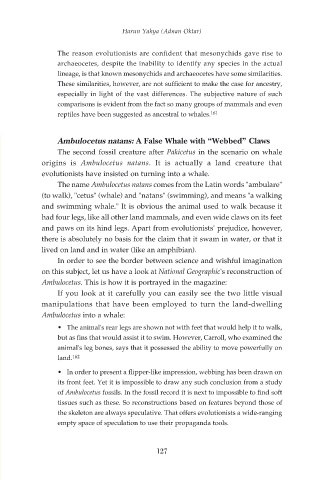Page 129 - Darwinism Refuted
P. 129
Harun Yahya (Adnan Oktar)
The reason evolutionists are confident that mesonychids gave rise to
archaeocetes, despite the inability to identify any species in the actual
lineage, is that known mesonychids and archaeocetes have some similarities.
These similarities, however, are not sufficient to make the case for ancestry,
especially in light of the vast differences. The subjective nature of such
comparisons is evident from the fact so many groups of mammals and even
reptiles have been suggested as ancestral to whales. 161
Ambulocetus natans: A False Whale with “Webbed” Claws
The second fossil creature after Pakicetus in the scenario on whale
origins is Ambulocetus natans. It is actually a land creature that
evolutionists have insisted on turning into a whale.
The name Ambulocetus natans comes from the Latin words "ambulare"
(to walk), "cetus" (whale) and "natans" (swimming), and means "a walking
and swimming whale." It is obvious the animal used to walk because it
had four legs, like all other land mammals, and even wide claws on its feet
and paws on its hind legs. Apart from evolutionists' prejudice, however,
there is absolutely no basis for the claim that it swam in water, or that it
lived on land and in water (like an amphibian).
In order to see the border between science and wishful imagination
on this subject, let us have a look at National Geographic's reconstruction of
Ambulocetus. This is how it is portrayed in the magazine:
If you look at it carefully you can easily see the two little visual
manipulations that have been employed to turn the land-dwelling
Ambulocetus into a whale:
• The animal's rear legs are shown not with feet that would help it to walk,
but as fins that would assist it to swim. However, Carroll, who examined the
animal's leg bones, says that it possessed the ability to move powerfully on
land. 162
• In order to present a flipper-like impression, webbing has been drawn on
its front feet. Yet it is impossible to draw any such conclusion from a study
of Ambulocetus fossils. In the fossil record it is next to impossible to find soft
tissues such as these. So reconstructions based on features beyond those of
the skeleton are always speculative. That offers evolutionists a wide-ranging
empty space of speculation to use their propaganda tools.
127

